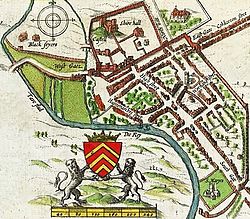St Mary's Church, Cardiff: Difference between revisions
add image |
mNo edit summary |
||
| Line 8: | Line 8: | ||
By 1678, with evidence from the visit of [[Francis Place (artist)|Francis Place]] and later the Celtic scholar [[Edward Lhuyd]], both now described St Mary's as being in ruins. However, it was not until 1698 that the last recorded burial in the churchyard took place.<ref name=Cardiffians/> |
By 1678, with evidence from the visit of [[Francis Place (artist)|Francis Place]] and later the Celtic scholar [[Edward Lhuyd]], both now described St Mary's as being in ruins. However, it was not until 1698 that the last recorded burial in the churchyard took place.<ref name=Cardiffians/> |
||
After the diversion of the River Taff by [[Isambard Kingdom Brunel]] to build [[Cardiff Central railway station]] in 1850, and the resultant creation of [[Westgate Street (Cardiff)|Westgate Street]], the site was the location of the ''Prince of Wales theatre''. Itself demolished, the site is now the location of the current ''Prince of Wales'' [[public house]].<ref name=Cardiffians/> |
After the diversion of the River Taff by [[Isambard Kingdom Brunel]] to build [[Cardiff Central railway station]] in 1850, and the resultant creation of [[Westgate Street (Cardiff)|Westgate Street]], the site was the location of the ''Prince of Wales theatre''. Itself demolished, the site is now the location of the current ''Prince of Wales'' [[public house]].<ref name=Cardiffians/> In 1843, the Earl of Bute paid for the construction of the [[Church of St. Mary the Virgin and St. Stephen the Martyr]] in [[Bute Street (Cardiff)|Bute Street]] as a permenant replacement. |
||
==References== |
==References== |
||
Revision as of 23:15, 31 December 2011

St Mary's Church was an Anglican church which stood at the south end of the current St. Mary's Street, Cardiff, from 1107 until 1620. Located next to the River Taff, it was susceptible to flooding, and so the monks were withdrawn by the sponsoring Tewkesbury Abbey in 1211.[1]
After the Bristol Channel floods of 1607 washed away much of its foundations, it slowly began to collapse. The decision was made to make St John's the main parish church, which was originally just an offshot development. The two churches were worked as one parish, with all burials and some services continuing at St Mary's.
In 1638 the vicar of St Mary's, William Ebery was forced to resign, his curate Walter Cradock had his licence revoked, and senior members of the congreation were barred from the premises after they refused to read the Book of Sports. These people together with others of a similar mind formed the core of a congregation, that after the English Civil War and subsequent Restoration, in 1696 were granted land in Womanby Street by Alderman John Archer. This allowed them to build the first Trinity Church, later known as a Presbyterian chapel.[2]
By 1678, with evidence from the visit of Francis Place and later the Celtic scholar Edward Lhuyd, both now described St Mary's as being in ruins. However, it was not until 1698 that the last recorded burial in the churchyard took place.[1]
After the diversion of the River Taff by Isambard Kingdom Brunel to build Cardiff Central railway station in 1850, and the resultant creation of Westgate Street, the site was the location of the Prince of Wales theatre. Itself demolished, the site is now the location of the current Prince of Wales public house.[1] In 1843, the Earl of Bute paid for the construction of the Church of St. Mary the Virgin and St. Stephen the Martyr in Bute Street as a permenant replacement.
References
- ^ a b c "Timeline". Cardiffians.co.uk. Retrieved 2011-12-31.
- ^ "Trinity Chapel". ancestry.com. Retrieved 2012-12-30.
